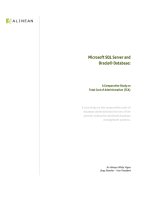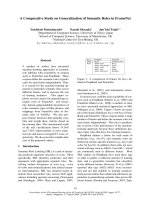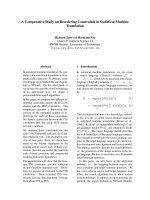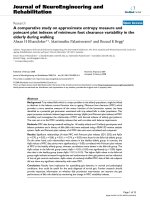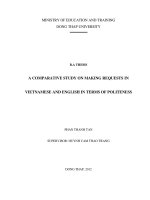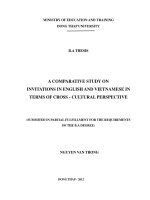b.a thesis a comparative study on invitations in english and vietnamese in terms of cross cultural perspective
Bạn đang xem bản rút gọn của tài liệu. Xem và tải ngay bản đầy đủ của tài liệu tại đây (643.78 KB, 91 trang )
MINISTRY OF EDUCATION AND TRAINING
DONG THAP UNIVERSITY
B.A THESIS
A COMPARATIVE STUDY ON
INVITATIONS IN ENGLISH AND VIETNAMESE IN
TERMS OF CROSS - CULTURAL PERSPECTIVE
(SUMMITED IN PARTIAL FULFILLMENT FOR THE REQUIREMENTS
OF THE B.A DEGREE)
NGUYEN VAN TRONG
DONG THAP - 2012
MINISTRY OF EDUCATION AND TRAINING
DONG THAP UNIVERSITY
B.A THESIS
A COMPARATIVE STUDY ON
INVITATIONS IN ENGLISH AND VIETNAMESE IN
TERMS OF CROSS - CULTURAL PERSPECTIVE
(SUMMITED IN PARTIAL FULFILLMENT FOR THE REQUIREMENTS
OF THE B.A DEGREE)
NGUYEN VAN TRONG
SUPERVISOR: HUYNH CAM THAO TRANG, M.A
DONG THAP - 2012
i
ii
DECLARATION
I, hereby, declare that my thesis entitled: "A Comparative Study on Invitations in
English and Vietnamese In Terms of Cross - Cultural Perspective" is the result
of my own work, submitted in the fulfillment for the requirements of the B.A degree.
Except where the reference is indicated, no other person’s work has been used
without due acknowledgment in the text of the thesis.
Cao Lanh City - April, 2012
Nguyen Van Trong
ii
ii
TABLE OF CONTENTS
DECLARATION i
TABLE OF CONTENTS ii
ACKNOWLEDGMENTS v
ABSTRACT vi
LIST OF TABLES vii
LIST OF FIGURES vii
LIST OF ABBREVIATIONS AND NOTIFICATION CONVENTIONS viii
CHAPTER ONE: INTRODUCTIONS 1
1.1. Motivation for the study 1
1.2. Aims of the study 3
1.3. Research methods 3
1.4. Scope of the study 4
1.5. Significance of the study 4
1.6. Previous related studies 5
1.7. Organization of the study 5
CHAPTER TWO: LITERATURE REVIEW 7
2. 1. Politeness strategies 7
2.2. Generalization of speech acts 11
2.2.1. Definitions of speech acts 11
2.2.2. Classification of speech acts 13
2.3. Invitations as speech acts 15
2.4. Pragmatics and cross-cultural pragmatics 16
2.5. Categories of inviting in English and Vietnamese 18
2.5.1. Categories of inviting in English 19
2.5.1.1. Direct invitations in English 19
2.5.1.2. Indirect invitations in English 21
iii
ii
2.5.2. Categories of inviting in Vietnamese 22
2.5.2.1. Direct invitations in Vietnamese 22
2.5.2.2. Indirect invitations in Vietnmaese 24
CHAPTER THREE: METHODOLOGY 27
3.1. Research questions 27
3.2. Research participants 27
3.3. Research procedure 29
3.4. Data collection instruments 29
3.4.1. The survey questionnaires 29
3.4.2. Personal observations 32
3.5. Data analysis method 32
CHAPTER FOUR: RESULTS AND DISCUSSION 33
4. 1. An overview of results 34
4.1.1. An overview of results in equal power settings 34
4.1.2. An overview of results high power settings 35
4.1.3. An overview of results low power settings 36
4.2. Results of data analysis 37
4.2.1. The choice of inviting forms in equal power settings 38
4.2.2. The choice of inviting forms in high power settings 41
4.2.3. The choice of inviting forms in low power settings 45
4.3. Discussion 48
4.3.1. Research question 1
4.3.1.1. Similarities 49
4.3.3.2. Differences 50
4.3.2. Research question 2
iv
ii
CHAPTER FIVE: CONCLUSIONS 56
5.1. Summary, major findings and implications on teaching 56
5.1.1. Summary 56
5.1.2. Major findings 57
5.1.3. Implications on teaching 58
5.2. Limitations of the study and suggestions for further studies 60
5.2.1. Limitations of the study 60
5.2.2. Suggestions for further studies 60
REFERENCES
In English
In Vietnamese
APPENDICES
Appendix 1: Survey Questionnaire 1 (English version)
Appendix 2: Survey Questionnaire 2 (Vietnamese version)
Appendix 3: Observation sheet
Appendix 4: Invitations provided by English participants
Appendix 5: Invitations provided by Vietnamese participants
v
ii
ACKNOWLEDGMENTS
I would like to express my deepest gratitude to my supervisor, M.A. Huynh Cam
Thao Trang, for her enthusiastic and useful guidance, insightful comments, and
encouragement without which my thesis would not have been completed.
My special thanks go to all my lecturers in Foreign Language Department, Dong
Thap University for their precious assistance, knowledge and enthusiasm.
I am grateful to all the participants for their enthusiastic participation in the thesis.
Especially, I am indebted to my classmates in ĐHSAnh 08A, especially Nguyen Thi
Phuong Dung and Phan Thanh Tan, for their great support.
Last but not least, I would like to express my indebtedness to my family, especially
my parents, brothers and sisters who have given me constant support and love
during the completion of the thesis.
Nguyen Van Trong
vi
ii
ABSTRACT
This study which focused on speech acts of invitation, was conducted in the hope of
finding out the similarities and differences between how invitations are made in
English and Vietnamese by the people who are speaking these two languages under
the light of contrastive analysis and cross-cultural perspective. Data used for
analysis in this study were mainly collected through survey questionnaires, Through
analysis of forms of inviting provided by two groups of participants, it was deduced
that native speakers of English and Vietnamese are quite different in making
invitations under three social variables: social distance, relative power, and threats to
each other's negative face. One of the prominent results from data analysis is that
Vietnamese invitations are more diverse in terms of structural diversity, and
Vietnamese speakers are more direct in extending invitations in comparison to
English ones. Once, similarities and differences have been identified, implications
on teaching this speech were made.
vii
ii
LIST OF TABLES
Table 2.2.2: Speech acts classification 14
Table 5.1: Forms of Invitations in English and Vietnamese 25
Table 3.2. Information on the research participants 29
Table 4.1.1 An overview of results in equal power settings 34
Table 4.1.2. An overview of results in high power settings 36
Table 4.1.3. An overview of results in low power settings 37
LIST OF FIGURES
Figure 4.2.1.a Forms of inviting provided by the English and Vietnamese
participants: situation 1 38
Figure 4.2.1.b. Forms of inviting provided by the English and Vietnamese
participants: situation 2 40
Figure 4.2.2.a. Forms of inviting provided by the English and Vietnamese
participants: situation 3 41
Figure 4.2.2.b. Forms of inviting provided by the English and Vietnamese
participants: situation 4 43
Figure 4.2.3.a. Forms of inviting provided by the English and Vietnamese
participants: situation 5 45
Figure 4.2.3.b. Forms of inviting provided by the English and Vietnamese
participants: situation 6 47
viii
ii
LIST OF ABBREVIATIONS AND NOTATIONAL CONVENTIONS
D: social distance
P: relative power
R: ranking of impositions
(S25): each sentence is assigned a number in the list of invitations provided by the
participants.
Italics type is used for terms and examples
1
CHAPTER ONE: INTRODUCTIONS
This chapter introduces some very first parts of the thesis. It is comprised of
seven parts: (1) motivation for the study; (2) aims of the study; (3) research methods;
(4) scope of the study; (5) significance of the study; (6) previous related studies and
(7) organization of the study.
1.1. Motivation for the study
It is often said that to master a foreign language is difficult because enormous
vocabulary and profound understanding in grammar are not enough. Having certain
understandings of the culture where that language is spoken is a must. Let take
English and Vietnamese as an example. There are differences in the use of language
between English and Vietnamese. To immerse into the culture and daily life of the
target language is a must in order to comprehend wholly that language. In another
words, to learn a language means to learn the culture of the country where that
language is spoken. Acquiring a second language demands more than learning new
words and another system of grammar (Levine and Adelman, 1982). The goal of
learning a language, these days, is to be able to carry out effective communication.
Communication, however, may fail to achieve as there is lack of certain
understandings of the country where that language is spoken. There are “unwritten
rules” are potentially confusing and create misunderstandings even for native
speakers (Levine & Adelman, 1982). A deep understanding of culture may benefit
students in terms of interacting with people in the native country where their target
language is widely spoken. As a result, there should be a stress on the application of
combining culture to learning a language.
Language and culture can not be separated from each other. Each country has its
own traditions, customs, rituals reflected by the language. Understanding social
conventions and attention to such concepts as politeness, and face, which are
important to members in a particular culture, will certainly enable us to better
2
comprehend the different ways of speaking by people from different cultures, thus
helping eliminate ethnic stereotypes and misunderstandings. Problems arise as
language learners are not competent and fail to understand the cultural- social
aspects of communication. Take speech acts of invitation as an example. Vietnamese
saying goes: "khách đến nhà không trà thì bánh" (when guests come, either tea or
cakes should be served). This saying highlights the importance of inviting in
Vietnamese culture, where invitation speech acts make up a high proportion in daily
interactions. Inviting undoubtedly plays an important role in communication in all
cultures. Wall (1987) indicated that many of our daily social interactions involve
making invitations and responding to them. In daily social life, people are
sometimes invited to go somewhere or to do something on important occasions such
as weddings, birthdays, and graduations, to small ones like movies, eating out, or
vendors in the markets invite customers to buy their items. Take these two following
sentences as examples:
(1) Alan and I wanted to have a few people over for a dinner party to
celebrate finishing my dissertation, and we’d like to invite you especially, since
you’re chairman. (Tillitt & Bruder, 1999, p.23).
(2) Ăn cho vui. Cô Nga. (Thach Lam, 2000, p.167)
Invitations help to establish, maintain, reinforce and further strengthen social
rapports. Americans and Vietnamese share certain similarities in terms of making
and responding to invitations in social interactions. However, differences are
undoubtedly numerous. Many cases of making invitations are different in Vietnam
and American. Mastering how to make appropriate invitations which are suitable to
a particular culture should be taken in considerations so as not to cause hurts, shocks,
misunderstandings, and misinterpretations. A frequently misunderstood area in
American verbal interaction is that of extending, accepting, and refusing invitations
(Levine & Adelman, 1982). Moreover, helping Vietnamese learners of English
master and use invitation-making effectively is a must.
3
For the above reasons, the study is carried out to find out the differences of how
invitations are made in English and Vietnamese and to help Vietnamese learners
keep conversations with foreigners going on. Furthermore, the study is a hope to
give some reliable suggestions for teaching making invitations in particular, and
raise the importance of applying cross-cultural activities to teaching and learning
English to English majors in Dong Thap University in general. As a result the
following research questions are addressed:
1. What are the major similarities and differences in the ways native speakers
of English and native speakers of Vietnamese making invitations?
2. Do social distance (D), relative power (P), and ranking of impositions (R)
affect the choice of inviting forms by native speakers of English and Vietnamese
native speakers?
1.2. Aims of the study
The thesis aims to point out the similarities and differences in the way English and
Vietnamese native speakers making invitations. The thesis, in addition, aims to give
an insight into making invitations for English majors in Dong Thap University.
Moreover, it is intended to provide some reliable implications for teaching
invitation-making to English majors in Dong Thap University.
1.3. Research methods
In order to achieve the goals of a cross-cultural study mentioned earlier, the major
method to be employed in the study is a quantitative one. Also, contrastive analysis
is used. Therefore, the considerations, remarks, consumptions, comments and
conclusions in the thesis are mainly based on data analysis.
A number of data relating to making invitations in both English and Vietnamese
publications are collected from textbooks, short stories, books on English and
Vietnamese languages. They are then analyzed in the light of cross-cultural
perspective and analysis.
4
Survey questionnaire, in addition, is conducted. It is carefully designed to
investigate the cross-cultural similarities and differences in making invitations
between the Vietnamese and English languages. In order to collect data for
contrastive analysis, two types of survey questionnaires are designed: one in English
and the other in Vietnamese. They are next delivered thirty native speakers of
English in Ho Chi Minh City, where many foreigners live and work and thirty native
speakers of Vietnamese as well. Data collected will then be analyzed in order to find
out the similarities and differences between inviting in the English and Vietnamese
languages.
Furthermore, personal observations are also carried out in different social
situations, in which people make invitations. Observation work is taken placed in
three different social contexts including university campus, market, park, and family
in which the ways interlocutors invite invitations are to be particularly noted down.
They are indispensable parts in the study in terms of setting up the hypothesis in the
thesis.
1.4. Scope of the study
The study focuses on speech acts of invitations performed by native speakers of
English and then compare them to those performed by Vietnamese native speakers in
order to investigate the similarities and differences between the two groups of
participants under the light of cross-cultural perspective. The theoretical background
presented in this thesis concerns with the speech acts theory and politeness strategies.
Due to the scope of an B.A thesis, time and experience limitations, the thesis is
limited to verbal aspects of making invitations, any feature relating to phonology
such as sounds, stress, intonation will be not discussed here in the thesis.
1.5. Significance of the study
The study deals with making invitations speech acts, which set up and promote
social rapports among people in a particular culture. As stated in the motivation of
the study, invitations speech act is an indispensable part in daily communication.
5
The study is carried out with the hope to provide common understandings on making
invitations for Dong Thap University English-majors to avoid cultural conflicts and
effectively carrying out invitation-making in real life situations. In addition, the
study’s findings hope to make contributions to raising the importance of studying the
cross-culture for English majors in Dong Thap University.
1.6. Previous related studies
In 2005, in his dissertation “ Nghi thức lời nói trong tiếng Việt trên cơ sở lý thuyết
hành vi ngôn ngữ” (Speech etiquette in Vietnamese based on speech act theory),
Nguyen Van Lap has classified categories of invitations as speech etiquette in
Vietnamese in terms of speech act theory. The thesis introduced and analyzed two
main categories of invitations in Vietnamese including invitations with explicit
performative verbs and invitations with implicit performative verbs, which lays a
foundation for the data related to making invitations in Vietnamese in this study.
In autumn term 2008, in her study “ Politeness strategies in requests and
invitations: A comparative study between English and Vietnamese” Le Thi Mai
Hong focused and emphasized on politeness strategies used in the speech acts of
requests and invitations between English and Vietnamese. The study pointed some
major differences between politeness strategies employed in English invitations in
comparison with the Vietnamese ones.
The studies mentioned above are helpful to this study in terms of providing the
theoretical background for the thesis as they are closely related to making and
responding to invitations in English and Vietnamese right in the thesis.
1.7. Organization of the study
The thesis consists of five chapters:
Chapter 1: Introductions, this part presents the overview of the thesis including
motivation, aims, scope, research methods, significance, previous related studies as
6
well as the organization of the study.
Chapter 2: Literature review, this chapter provides the theoretical background
including speech act theory, politeness strategies, pragmatics and cross-cultural
pragmatics, and categories of inviting forms in English and Vietnamese.
Chapter 3: Methodology, this chapter focuses on presenting research questions,
research participants, research procedure, data collection, as well as methods of
analysis.
Chapter 4: Results and discussion, this chapter presents the results gained in survey
questionnaires and observation and discusses the similarities and differences in how
invitations speech acts are made in English and Vietnamese as well as the influence
of three variables to the choice of inviting forms of two groups of participants.
Chapter 5: Conclusions, this part summaries the major findings recorded during the
making of the thesis, presents the limitations of the study, provides some suggestions
for further research and give implications on teaching.
7
CHAPTER TWO: LITERATURE REVIEW
The literature review is organized into five parts: (1) politeness strategies (2)
generalization of speech acts, (3) invitations as speech acts (4) pragmatics and
cross-cultural pragmatics, (5) categories of inviting in English and Vietnamese. The
first part deals with literature on politeness strategies and their relations with
invitations in both languages.The second part aims to review the literature on the
definitions, classification of speech acts, as well as the existing theory on direct and
indirect speech acts. The next part concerns with invitations in terms of speech act
theory which involves the definitions, and categories of inviting in both languages.
The fourth part takes a look at pragmatics and cross-cultural pragmatics. Finally, the
fourth seeks the literature on inviting in English and Vietnamese.
2. 1. Politeness strategies
Politeness, an issue which has a great impact to human being and deeply influences
to human interaction, will be now discussed right in this part because
Politeness is basic to the production of social order, and a precondition of
human cooperation … any theory which provides an understanding of this
phenomenon at the same time goes to the foundation of human social life.
(Brown and Levinson, 1987)
In language studies, politeness implies the following: "(a) how languages
express the social distance between speakers and their different role relationships, (b)
"how face-work, that is, the attempt to establish, maintain, and save face during
conversation, is carried out in a speech community" (Richards et al. 1985, p.281).
Languages differ in how they express politeness. In English, phrases like It’s hot
here. I wonder if I could open the window? can be used to make a request more
polite. In other languages, the same effect can be expressed by a word or particle.
Politeness markers and the use of address forms convey differences between formal
8
speech and colloquial speech.
Human communication serves to establish and maintain not only a comfortable
relationship between people but also a social harmony. Therefore, in interpersonal
communication, in terms of politeness, every participant notes social factors such as
age, gender, power and distance among the interlocutors. Moreover, politeness may
be described as a form of behaviour which is exercised in order to consolidate and
promote relationship between individuals or, at least, to keep it undamaged.
According to Leech (1983), politeness means to minimize the effect of impolite
statement or expression (negative politeness) and maximize the effects of polite
illocutions (positive politeness) (Leech, 1983). However, the best-known theory is
developed by Brown and Levinson (1978, 1987). Their universalistic formulation of
politeness theory is problematic in some aspects.
The main issue of politeness is the notion of face. Face is defined as “the public
self-image that every member wants to claim for himself” (Brown and Levinson
1987, p.61). "Face" associates with the English idiom to lose face which means “to
do something which makes other people stop respecting you; to not maintain your
reputation and the respect of others”. Brown and Levinson treats the aspects of face
as “basic wants”, and distinguishes between positive face and negative face. Positive
face is interpreted as the want of every member to be desirable to, at least, some
others, whereas negative face is the want of every “competent adult member” for
his actions to be unimpeded by others (1987, p.62).
Moreover, Yule (1996) argues that in most English speaking contexts, the
participants in an interaction often have to determine, as they speak, the relative
social distance between them, and hence their face wants (1996, p.61)
“In everyday social interactions, people generally behave as if their public
self-image, or their face wants, will be respected. If a speaker says something that
represents a threat to another individual’s expectations regarding self-image, it is
9
described as a face threatening act. Alternatively, given the possibility that some
action might be interpreted t as a threat to another’s face, the speaker can say
something to lessen the possible threat. This is called a face saving act.” (Yule 1996,
p.61).
Analyzing politeness, the anthropologists Brown and Levinson (1987)
distinguishes between positive strategies of politeness, those which show
closeness, intimacy, and rapport between the speaker and the hearer, and negative
politeness strategies, those which indicate various degrees of social distance
between the speaker and hearer. In this sense, politeness varies to show awareness
of another person’s face in situations of social distance or closeness. The choice
of appropriate politeness strategies in a given context depends on a number of
factors. Brown and Levinson (1987) groups these factors into a simple formula
consisting of three independent variables, namely the social distance (D) of the
speaker and the hearer (a symmetric relation), the relative power (P) of the
speaker and the hearer (an asymmetric relation), and the absolute ranking of
impositions (R) in the particular culture.
The social distance (D) is a symmetric social dimension of similarity/difference
within which the speaker and the hearer stand for the purposes of this act. In some
situations, D is based on a evaluation of frequency of interaction and the types of
material and non-material goods (embracing face) between S and H. The evaluation
will be usually measures of social distance relied on stable social attributes.
The relative power (P) which is an asymmetric social dimension is the degree to
which H can impose his own plans and his own self– evaluation (face) at the
expense of S’s plans and self – evaluation. Generally, there are two sources of P,
either of which may be authorized or unauthorized – material control (over
economic distribution and physical force) and metaphysical control (over the actions
of others, by virtue of metaphysical forces subscribed to by those others.
The absolute ranking (R) of imposition which is situationally and cuturally
10
defined is the degree to which there is an interference in the speaker’s wants or self-
determination or approval (speaker’s negative and positive wants). There are
normally two scales or ranks which are identifiable 21 for negative–face: a ranking
of impositions in proportion to the expenditure of services (including the time
provision) and good (including non –material goods such as information, regard
expression and other face payments). As for positive – face, the, ranking of
imposition embraces an assessment of the amount of "pain" given to the hearer’s
face, based on the differences between the hearer’s desired self-image and that
presented in face threatening acts. Cultural rankings of facets of positive face (like
success, niceness, beauty etc.) can be reranked in specific circumstances, so do the
negative face rankings. Besides, that there are also personal rankings can explain
why some people object to certain kinds of face threatening acts and some do not.
These three factors affect indirectness in human interaction, especially in the
choice of politeness strategies which is an essential aspect of inviting. Together with
cross -cultural perspective, politeness is an another aspect which are used to create
the anlytical framework for data analysis.
Basing on the theory of Brown and Levinson (1987), a bank of 6 situations was
designed to elicit offers. These situations were grouped according to three variables,
namely social distance (D) of the speaker and the hearer, the relative power (P) of
the speaker and the hearer (an asymmetric relation), and the absolute ranking (R) of
impositions in the particular culture. The situations under study were as follows:
The speaker has more power than the hearer; they are unfamiliar with each other.
The speaker has more power than the hearer; they are familiar with each other
The speaker and the hearer are equal in power; they are unfamiliar with each
other.
The speaker and the hearer are equal in power; they are familiar with each other.
The speaker has less power than the hearer; they are unfamiliar with each other.
The speaker has less power than the hearer; they are familiar with each other.
11
2.2. Generalization of speech acts
2.2.1. Definitions of speech acts
J. Austin (1962) takes the pioneering role in formulating the theory of speech acts.
According to him, all utterances should be viewed as actions of the speakers, stating
or describing is only one function of language. He points out that the declarative
sentences are not only used to say things or describe states of affairs but also used to
do things.
Also, in 1962, he defines speech acts as the actions performed in saying
something. When people produce utterances, they often perform actions via those
utterances. These actions are called speech acts: such as apology, complaint,
compliment, invitation, promise, or request. A speech act is part of a speech event.
The speech act performed by producing an utterance, consists of three related acts
including locutionary act, illocutionary act and perlocutionary act. They are listed as
follows:
Locutionary act is the basic act of producing a meaningful linguistic expression.
The locutionary act is performed with some purposes or functions in mind.
Illocutionary act is an act performed via the communicative force of an
utterance. In engaging in locutionary acts we generally also perform illocutionary
acts such as informing, advising, offer, promise, etc. In uttering a sentence by virtue
of conversational force associated with it.
Perlocutionary act is what we bring about or achieve by saying something, such
as convincing, persuading, deterring perlocutionary acts are performed only on the
assumption that the hearer will recognize the effect you intended.
Speech acts, since then, developed by many famous philosophers and have been
central to the works and further developed by many other philosophers and a great
concern of any research paper in terms of doing researches on linguistic fields.
12
The two other famous linguistic researchers are Schmidt and Richards who
reaffirm that: speech act theory has to do with the functions of languages, so in the
broader sense we might say that speech acts are all the acts we perform through
speaking, all things we do when we speak. The theory of speech acts is partly
taxonomic and partly explanatory. It must systematically classify types of speech
acts and the ways in which they can succeed or fail. It must reckon with the fact that
the relationship between the words being used and the force of their utterance is
often oblique.
Paltridge (2000) defines that a speech act is an utterance that serves a function in
communication. Some examples are an apology, greeting, request, complaint,
invitation, compliment or refusal. A speech act might contain just one word such as
"No" to perform a refusal or several words or sentences such as: "I' m sorry, I can't, I
have a prior engagement". It is important to mention that speech acts include
real-life interactions and require not only knowledge of the language but also
appropriate use of that language within a given culture. Socio-cultural variables like
authority, social distance, and situational setting influence the appropriateness and
effectiveness of politeness strategies used to realize directive speech acts such as
requests (p.15).
Yule (1996, p.47), another famous linguist, defines that "in attempting to
express themselves, people do not only produce utterances containing grammatical
structures and words, they perform actions via those utterances." According to him,
actions performed via utterances are speech acts.
In daily communication, people perform speech acts when they offer an apology,
greeting, complaint, invitation, compliment or refusal. Since people often do more
things with words than merely convey what words encode, speech acts have to be
seen from real-life interactions. For example, in a classroom situation, when a
teacher says:
(1) May I have your attention?
13
(1) is a request more than a question. In the same way, when a student talks to his
friend,
(2) We’re having some people over Saturday evening and wanted to know if
you’d like to join us.
(2) is an invitation more than a question. Moreover, speech acts require not only
knowledge of any languages but also the culture of the country where this
language is use. For examples in Vietnamese when we utter:
(3) Where are you going?
(3) means we are greeting the people we meet.
2.2.2. Classification of speech acts
According to Yule (1996), there is one general classification system that lists five
types of general functions performed by speech acts including declarations,
representatives, expressives, directives, and commissives.
Declarations are speech acts that change the world via their utterance. The
speaker has to have a special institutional role, in a specific context, in order to
perform a declaration appropriately. For example, "Priest: I now pronounce you
husband and wife."
Representatives are speech acts that state what the speaker believes to be the
case or not. Statement of fact, assertions, conclusions and descriptions are examples
of the speaker representing the world as he or she believes it is. For example, “The
Moon goes round the Earth." or "It is windy today."
Expressives are speech acts that state what the speaker feels. They express
psychological states and can be statement of pleasure, pain, likes, dislikes, joy and
sorrow. For example, "What a great party!".
Directives are speech acts that the speakers use to get the Hearer to do
something. They express what the speaker wants. For instance, "Stand up, please!"
or "Could you open the door?".
14
Commissives are speech acts that speakers use to commit themselves to some
future action. They express what the speaker intends. For example: "I’ll give one
hand." or "I’ll be back."
Yule (1996) also presents a table showing speech acts classification as follows:
Table 2.2.2: Speech acts classification
Speech act types
Direction of fit
S = Speaker
X = Situation
Declarations
Representatives
Expressives
Directives
Commissives
words change the world
makes words fits the world
makes words fits the world
make the world fits words
make the world fits words
S causes X
S believes X
S feels X
S wants X
S intends X
The usefulness of speech acts analysis is illustrating the kinds of things we can
do with words and identifying some of the conventional utterance forms we use to
perform specific actions. However, we need to look at more extended interaction to
understand how those actions are carried out and interpreted within speech events.
However, to compare selected speech acts from two languages, the topic is still
vast and could not be treated exhaustively in any one work. The cultural norms
reflected in speech acts differ not only from one language to another, but also from
one regional and social variety to another. So, different cultures find expression in
different system of speech acts, and that different speech acts become entrenched,
and, to some extent, codified in different languages.
Of these types, the characteristics of invitations can be easily recognised in
commissives and directives. In our daily interactions, inviting is one kind of speech
act that is commonly used with high frequency.
15
2.2.3. Direct and indirect speech acts
In the former part, classification of speech acts have been made clear in terms of the
speaker's intention of Yule (1996). This part take a look at another way of classifying
speech acts.
Another approach to distinguish different types of speech acts is based on the
relationship between the structure and the function. Yule (1996) claims that three
structural forms (declarative, interrogative, imperative) and three general
communicative function (statement, question, command/request) can be combined
to create two other types of speech acts: direct and indirect speech acts. The
following example illustrates this:
Yule (1996) defines that whenever there is an indirect relationship between a
structure and a function, we have an direct speech act as in the following examples
(4) Do join me for a coffee? (Le Huy Lam, 2000)
Whenever there is an indirect relationship between a structure and a function, we
have an indirect speech act as in the following examples.
(5) Would you like to come over for dinner tomorrow? (Tillitt & Bruder, 1999)
It is not only used as a question but also a request, hence it is considered to be an
indirect speech act. He adds that indirect speech acts are generally associated with
greater politeness in English than direct speech acts.
2.3. Invitations as speech acts
There are, first, two concepts that are needed to make clear, namely invite and
invitation. Oxford Advanced Learner's Dictionary indicates that to invite means to
ask somebody to come to a social event or to ask somebody formally to go to
somewhere or do something. According to Cambridge Advanced Learner’s
Dictionary, an invitation means a polite request in which a person is asked to come to
an event or to perform some task as in the examples below:
